Government Expenditure Policies and Their Effect on Income Inequality
VerifiedAdded on 2023/06/10
|8
|2390
|334
Essay
AI Summary
This essay explores the multifaceted relationship between government expenditure and income inequality, drawing on various research articles to analyze the effectiveness of different policies and strategies. It examines how governments globally employ methods such as wealth redistribution through taxation to address economic disparities and alleviate poverty. The analysis includes a review of literature discussing the impact of fiscal and monetary policies, the allocation of public spending, and the role of government investment in education and healthcare. Furthermore, the essay considers the potential for both positive and negative impacts of government spending, highlighting the importance of efficient and targeted resource allocation to achieve equitable economic growth. Ultimately, the essay synthesizes these insights to provide a comprehensive understanding of the challenges and opportunities in using government expenditure as a tool for reducing income inequality.
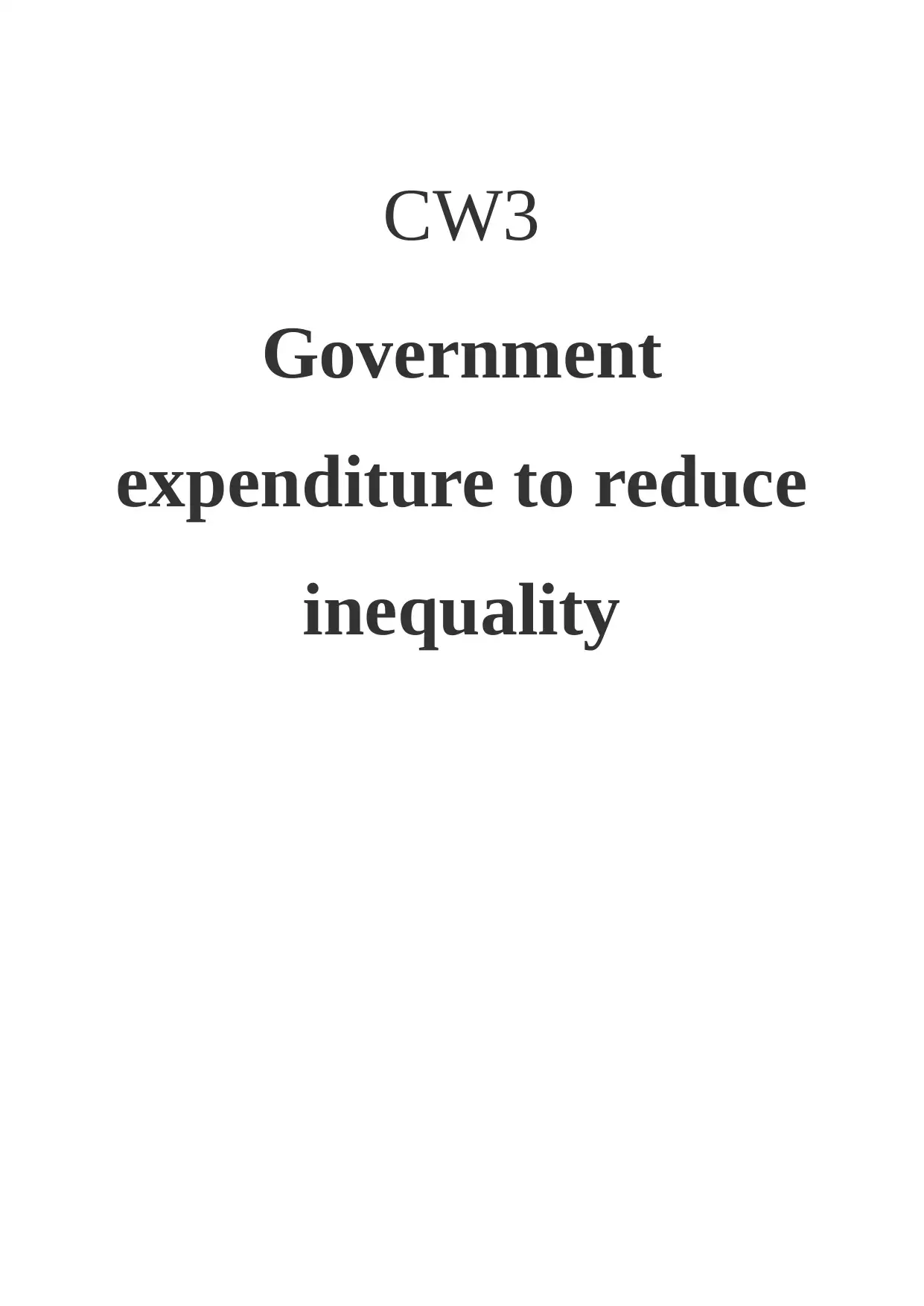
CW3
Government
expenditure to reduce
inequality
Government
expenditure to reduce
inequality
Paraphrase This Document
Need a fresh take? Get an instant paraphrase of this document with our AI Paraphraser
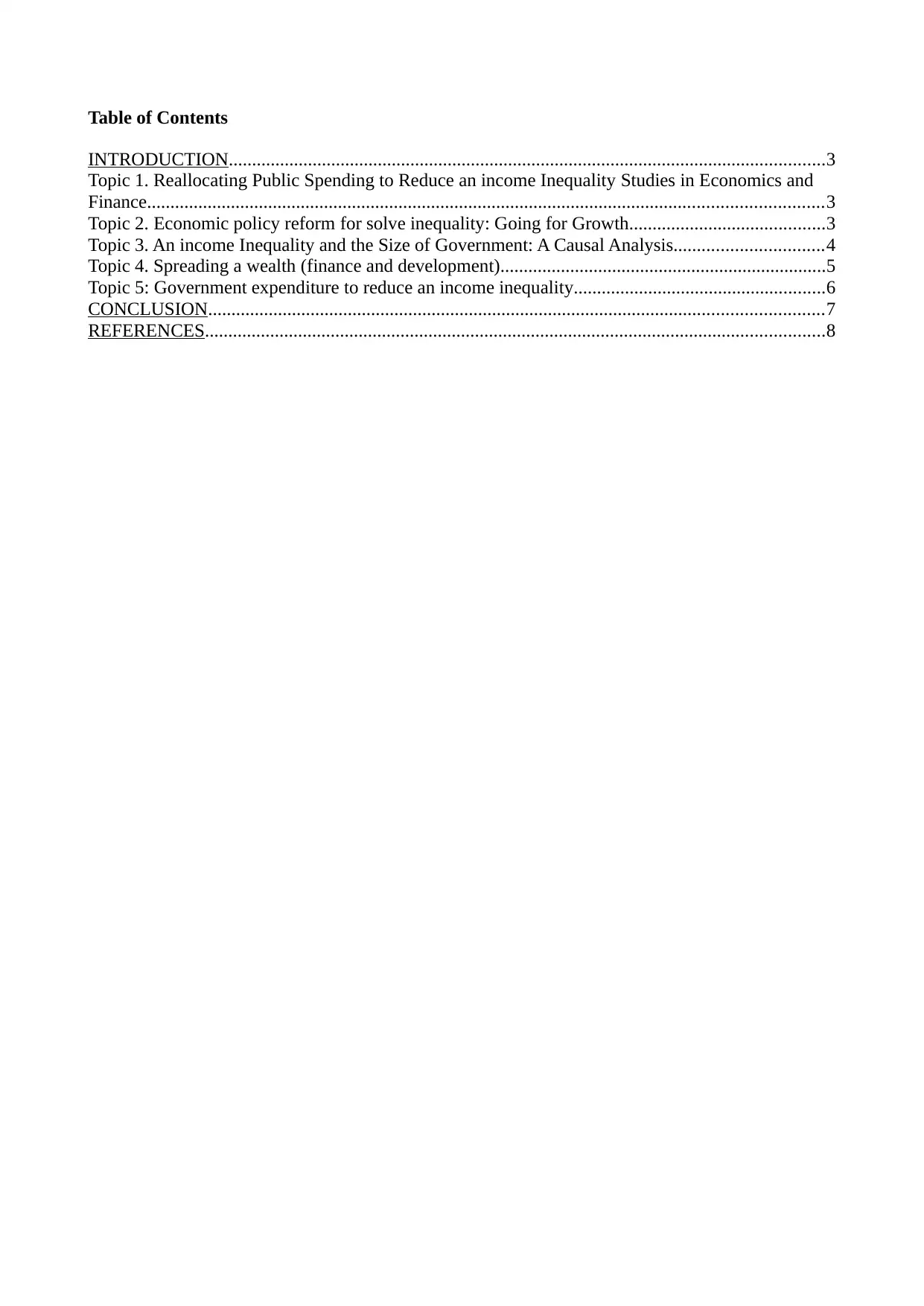
Table of Contents
INTRODUCTION................................................................................................................................3
Topic 1. Reallocating Public Spending to Reduce an income Inequality Studies in Economics and
Finance.................................................................................................................................................3
Topic 2. Economic policy reform for solve inequality: Going for Growth..........................................3
Topic 3. An income Inequality and the Size of Government: A Causal Analysis................................4
Topic 4. Spreading a wealth (finance and development)......................................................................5
Topic 5: Government expenditure to reduce an income inequality......................................................6
CONCLUSION....................................................................................................................................7
REFERENCES.....................................................................................................................................8
INTRODUCTION................................................................................................................................3
Topic 1. Reallocating Public Spending to Reduce an income Inequality Studies in Economics and
Finance.................................................................................................................................................3
Topic 2. Economic policy reform for solve inequality: Going for Growth..........................................3
Topic 3. An income Inequality and the Size of Government: A Causal Analysis................................4
Topic 4. Spreading a wealth (finance and development)......................................................................5
Topic 5: Government expenditure to reduce an income inequality......................................................6
CONCLUSION....................................................................................................................................7
REFERENCES.....................................................................................................................................8

INTRODUCTION
The government of the United Kingdom has devised a variety of methods and tactics to
impact the economics of their country. It has been shown that while different countries confront
different obstacles inside their borders, they all share the same goals. One of the really important
government efforts is that they frequently allocate revenue by different means including taxes on
the wealthy out from state's economy. The government's major goal in terms of wealth dispersal is
to eradicate economic disparity and protect their nation from falling into poverty. In the instance of
the United Kingdom, the nation's government officials withhold a portion of money mostly from
high-income individuals, which they then utilise explicitly or implicitly for the benefit of the
impoverished residents who stay there. Because the United Kingdom has indeed attempted to
allocate an equitable proportion of governmental expenditure as a percentage across their state, they
have followed a structured technique to help them discern the wealth levels of individuals living
within their country. The country's budget strategies play a huge part in assisting them in eradicating
poverty through ensuring that monies are spent appropriately.
Topic 1. Reallocating Public Spending to Reduce an income Inequality Studies in
Economics and Finance.
This article will review some of the most important issues that arise in the nation in which
one of the major issues is poverty. The UK government is constantly attempting to boost
widespread poverty through numerous initiatives including redistributing wealth based on taxation
and other processes. As per this writer, the government of the United Kingdom can accept numerous
concerns, such as doing research studies instead of bridge linear regression. The writer's second
suggestion is that the research looks at the problem of growing inequality in their nation. The third
aspect would be that the firm's administration must investigate various levels of disintegration and
therefore should aim to disperse funds across relatively broad groups. The researcher should
concentrate on domestic distribution, according to the four indicators given through this expert.
Finally, the author suggests that the nations specialised researcher research various modalities of
allocation in terms of enhancing the nation's unequal characteristics (Djeneba Doumbia and Tidiane
Kinda., 2019).
Topic 2.Economic policy reform for solve inequality: Going for Growth
According to this scholar, monetary policy has a significant impact on income and spending
disparity. The author of this report claims that fiscal austerity macroeconomic factors exacerbate US
inequalities. The author analyzes the traditional role of financial regulation in changing the level of
inequality in their nation. This essay also claims that the government can use a variety of
The government of the United Kingdom has devised a variety of methods and tactics to
impact the economics of their country. It has been shown that while different countries confront
different obstacles inside their borders, they all share the same goals. One of the really important
government efforts is that they frequently allocate revenue by different means including taxes on
the wealthy out from state's economy. The government's major goal in terms of wealth dispersal is
to eradicate economic disparity and protect their nation from falling into poverty. In the instance of
the United Kingdom, the nation's government officials withhold a portion of money mostly from
high-income individuals, which they then utilise explicitly or implicitly for the benefit of the
impoverished residents who stay there. Because the United Kingdom has indeed attempted to
allocate an equitable proportion of governmental expenditure as a percentage across their state, they
have followed a structured technique to help them discern the wealth levels of individuals living
within their country. The country's budget strategies play a huge part in assisting them in eradicating
poverty through ensuring that monies are spent appropriately.
Topic 1. Reallocating Public Spending to Reduce an income Inequality Studies in
Economics and Finance.
This article will review some of the most important issues that arise in the nation in which
one of the major issues is poverty. The UK government is constantly attempting to boost
widespread poverty through numerous initiatives including redistributing wealth based on taxation
and other processes. As per this writer, the government of the United Kingdom can accept numerous
concerns, such as doing research studies instead of bridge linear regression. The writer's second
suggestion is that the research looks at the problem of growing inequality in their nation. The third
aspect would be that the firm's administration must investigate various levels of disintegration and
therefore should aim to disperse funds across relatively broad groups. The researcher should
concentrate on domestic distribution, according to the four indicators given through this expert.
Finally, the author suggests that the nations specialised researcher research various modalities of
allocation in terms of enhancing the nation's unequal characteristics (Djeneba Doumbia and Tidiane
Kinda., 2019).
Topic 2.Economic policy reform for solve inequality: Going for Growth
According to this scholar, monetary policy has a significant impact on income and spending
disparity. The author of this report claims that fiscal austerity macroeconomic factors exacerbate US
inequalities. The author analyzes the traditional role of financial regulation in changing the level of
inequality in their nation. This essay also claims that the government can use a variety of
⊘ This is a preview!⊘
Do you want full access?
Subscribe today to unlock all pages.

Trusted by 1+ million students worldwide
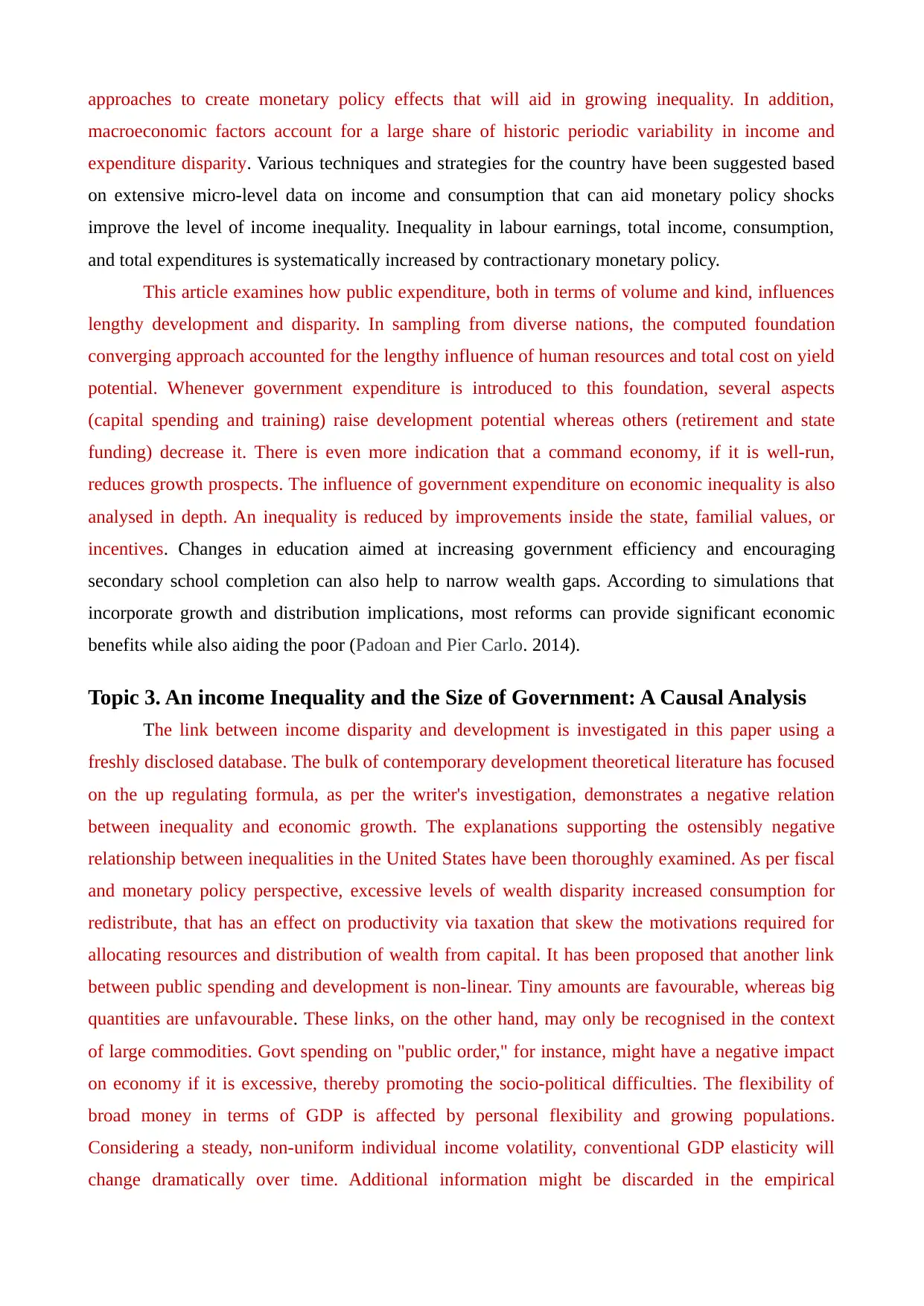
approaches to create monetary policy effects that will aid in growing inequality. In addition,
macroeconomic factors account for a large share of historic periodic variability in income and
expenditure disparity. Various techniques and strategies for the country have been suggested based
on extensive micro-level data on income and consumption that can aid monetary policy shocks
improve the level of income inequality. Inequality in labour earnings, total income, consumption,
and total expenditures is systematically increased by contractionary monetary policy.
This article examines how public expenditure, both in terms of volume and kind, influences
lengthy development and disparity. In sampling from diverse nations, the computed foundation
converging approach accounted for the lengthy influence of human resources and total cost on yield
potential. Whenever government expenditure is introduced to this foundation, several aspects
(capital spending and training) raise development potential whereas others (retirement and state
funding) decrease it. There is even more indication that a command economy, if it is well-run,
reduces growth prospects. The influence of government expenditure on economic inequality is also
analysed in depth. An inequality is reduced by improvements inside the state, familial values, or
incentives. Changes in education aimed at increasing government efficiency and encouraging
secondary school completion can also help to narrow wealth gaps. According to simulations that
incorporate growth and distribution implications, most reforms can provide significant economic
benefits while also aiding the poor (Padoan and Pier Carlo. 2014).
Topic 3. An income Inequality and the Size of Government: A Causal Analysis
The link between income disparity and development is investigated in this paper using a
freshly disclosed database. The bulk of contemporary development theoretical literature has focused
on the up regulating formula, as per the writer's investigation, demonstrates a negative relation
between inequality and economic growth. The explanations supporting the ostensibly negative
relationship between inequalities in the United States have been thoroughly examined. As per fiscal
and monetary policy perspective, excessive levels of wealth disparity increased consumption for
redistribute, that has an effect on productivity via taxation that skew the motivations required for
allocating resources and distribution of wealth from capital. It has been proposed that another link
between public spending and development is non-linear. Tiny amounts are favourable, whereas big
quantities are unfavourable. These links, on the other hand, may only be recognised in the context
of large commodities. Govt spending on "public order," for instance, might have a negative impact
on economy if it is excessive, thereby promoting the socio-political difficulties. The flexibility of
broad money in terms of GDP is affected by personal flexibility and growing populations.
Considering a steady, non-uniform individual income volatility, conventional GDP elasticity will
change dramatically over time. Additional information might be discarded in the empirical
macroeconomic factors account for a large share of historic periodic variability in income and
expenditure disparity. Various techniques and strategies for the country have been suggested based
on extensive micro-level data on income and consumption that can aid monetary policy shocks
improve the level of income inequality. Inequality in labour earnings, total income, consumption,
and total expenditures is systematically increased by contractionary monetary policy.
This article examines how public expenditure, both in terms of volume and kind, influences
lengthy development and disparity. In sampling from diverse nations, the computed foundation
converging approach accounted for the lengthy influence of human resources and total cost on yield
potential. Whenever government expenditure is introduced to this foundation, several aspects
(capital spending and training) raise development potential whereas others (retirement and state
funding) decrease it. There is even more indication that a command economy, if it is well-run,
reduces growth prospects. The influence of government expenditure on economic inequality is also
analysed in depth. An inequality is reduced by improvements inside the state, familial values, or
incentives. Changes in education aimed at increasing government efficiency and encouraging
secondary school completion can also help to narrow wealth gaps. According to simulations that
incorporate growth and distribution implications, most reforms can provide significant economic
benefits while also aiding the poor (Padoan and Pier Carlo. 2014).
Topic 3. An income Inequality and the Size of Government: A Causal Analysis
The link between income disparity and development is investigated in this paper using a
freshly disclosed database. The bulk of contemporary development theoretical literature has focused
on the up regulating formula, as per the writer's investigation, demonstrates a negative relation
between inequality and economic growth. The explanations supporting the ostensibly negative
relationship between inequalities in the United States have been thoroughly examined. As per fiscal
and monetary policy perspective, excessive levels of wealth disparity increased consumption for
redistribute, that has an effect on productivity via taxation that skew the motivations required for
allocating resources and distribution of wealth from capital. It has been proposed that another link
between public spending and development is non-linear. Tiny amounts are favourable, whereas big
quantities are unfavourable. These links, on the other hand, may only be recognised in the context
of large commodities. Govt spending on "public order," for instance, might have a negative impact
on economy if it is excessive, thereby promoting the socio-political difficulties. The flexibility of
broad money in terms of GDP is affected by personal flexibility and growing populations.
Considering a steady, non-uniform individual income volatility, conventional GDP elasticity will
change dramatically over time. Additional information might be discarded in the empirical
Paraphrase This Document
Need a fresh take? Get an instant paraphrase of this document with our AI Paraphraser
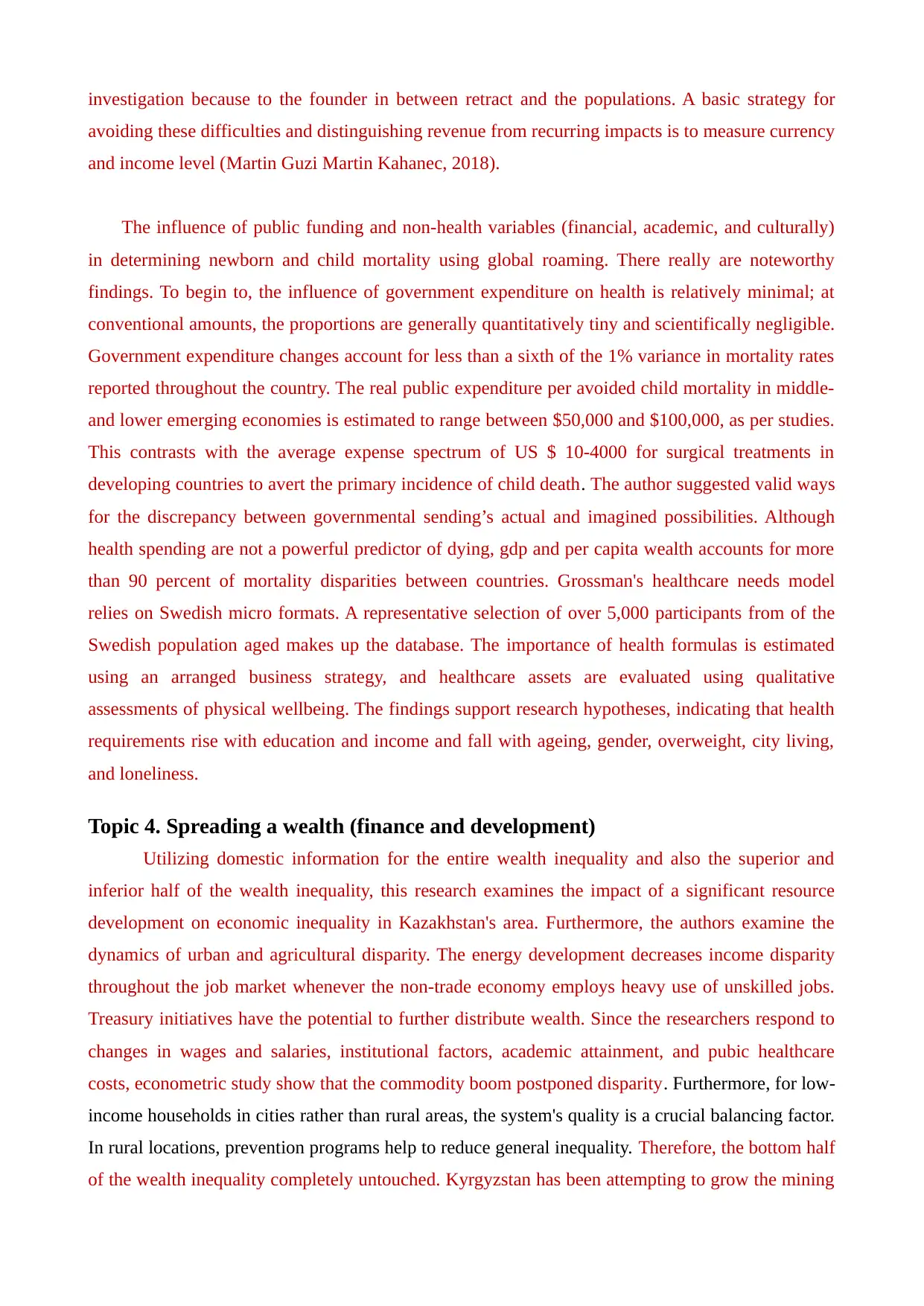
investigation because to the founder in between retract and the populations. A basic strategy for
avoiding these difficulties and distinguishing revenue from recurring impacts is to measure currency
and income level (Martin Guzi Martin Kahanec, 2018).
The influence of public funding and non-health variables (financial, academic, and culturally)
in determining newborn and child mortality using global roaming. There really are noteworthy
findings. To begin to, the influence of government expenditure on health is relatively minimal; at
conventional amounts, the proportions are generally quantitatively tiny and scientifically negligible.
Government expenditure changes account for less than a sixth of the 1% variance in mortality rates
reported throughout the country. The real public expenditure per avoided child mortality in middle-
and lower emerging economies is estimated to range between $50,000 and $100,000, as per studies.
This contrasts with the average expense spectrum of US $ 10-4000 for surgical treatments in
developing countries to avert the primary incidence of child death. The author suggested valid ways
for the discrepancy between governmental sending’s actual and imagined possibilities. Although
health spending are not a powerful predictor of dying, gdp and per capita wealth accounts for more
than 90 percent of mortality disparities between countries. Grossman's healthcare needs model
relies on Swedish micro formats. A representative selection of over 5,000 participants from of the
Swedish population aged makes up the database. The importance of health formulas is estimated
using an arranged business strategy, and healthcare assets are evaluated using qualitative
assessments of physical wellbeing. The findings support research hypotheses, indicating that health
requirements rise with education and income and fall with ageing, gender, overweight, city living,
and loneliness.
Topic 4. Spreading a wealth (finance and development)
Utilizing domestic information for the entire wealth inequality and also the superior and
inferior half of the wealth inequality, this research examines the impact of a significant resource
development on economic inequality in Kazakhstan's area. Furthermore, the authors examine the
dynamics of urban and agricultural disparity. The energy development decreases income disparity
throughout the job market whenever the non-trade economy employs heavy use of unskilled jobs.
Treasury initiatives have the potential to further distribute wealth. Since the researchers respond to
changes in wages and salaries, institutional factors, academic attainment, and pubic healthcare
costs, econometric study show that the commodity boom postponed disparity. Furthermore, for low-
income households in cities rather than rural areas, the system's quality is a crucial balancing factor.
In rural locations, prevention programs help to reduce general inequality. Therefore, the bottom half
of the wealth inequality completely untouched. Kyrgyzstan has been attempting to grow the mining
avoiding these difficulties and distinguishing revenue from recurring impacts is to measure currency
and income level (Martin Guzi Martin Kahanec, 2018).
The influence of public funding and non-health variables (financial, academic, and culturally)
in determining newborn and child mortality using global roaming. There really are noteworthy
findings. To begin to, the influence of government expenditure on health is relatively minimal; at
conventional amounts, the proportions are generally quantitatively tiny and scientifically negligible.
Government expenditure changes account for less than a sixth of the 1% variance in mortality rates
reported throughout the country. The real public expenditure per avoided child mortality in middle-
and lower emerging economies is estimated to range between $50,000 and $100,000, as per studies.
This contrasts with the average expense spectrum of US $ 10-4000 for surgical treatments in
developing countries to avert the primary incidence of child death. The author suggested valid ways
for the discrepancy between governmental sending’s actual and imagined possibilities. Although
health spending are not a powerful predictor of dying, gdp and per capita wealth accounts for more
than 90 percent of mortality disparities between countries. Grossman's healthcare needs model
relies on Swedish micro formats. A representative selection of over 5,000 participants from of the
Swedish population aged makes up the database. The importance of health formulas is estimated
using an arranged business strategy, and healthcare assets are evaluated using qualitative
assessments of physical wellbeing. The findings support research hypotheses, indicating that health
requirements rise with education and income and fall with ageing, gender, overweight, city living,
and loneliness.
Topic 4. Spreading a wealth (finance and development)
Utilizing domestic information for the entire wealth inequality and also the superior and
inferior half of the wealth inequality, this research examines the impact of a significant resource
development on economic inequality in Kazakhstan's area. Furthermore, the authors examine the
dynamics of urban and agricultural disparity. The energy development decreases income disparity
throughout the job market whenever the non-trade economy employs heavy use of unskilled jobs.
Treasury initiatives have the potential to further distribute wealth. Since the researchers respond to
changes in wages and salaries, institutional factors, academic attainment, and pubic healthcare
costs, econometric study show that the commodity boom postponed disparity. Furthermore, for low-
income households in cities rather than rural areas, the system's quality is a crucial balancing factor.
In rural locations, prevention programs help to reduce general inequality. Therefore, the bottom half
of the wealth inequality completely untouched. Kyrgyzstan has been attempting to grow the mining
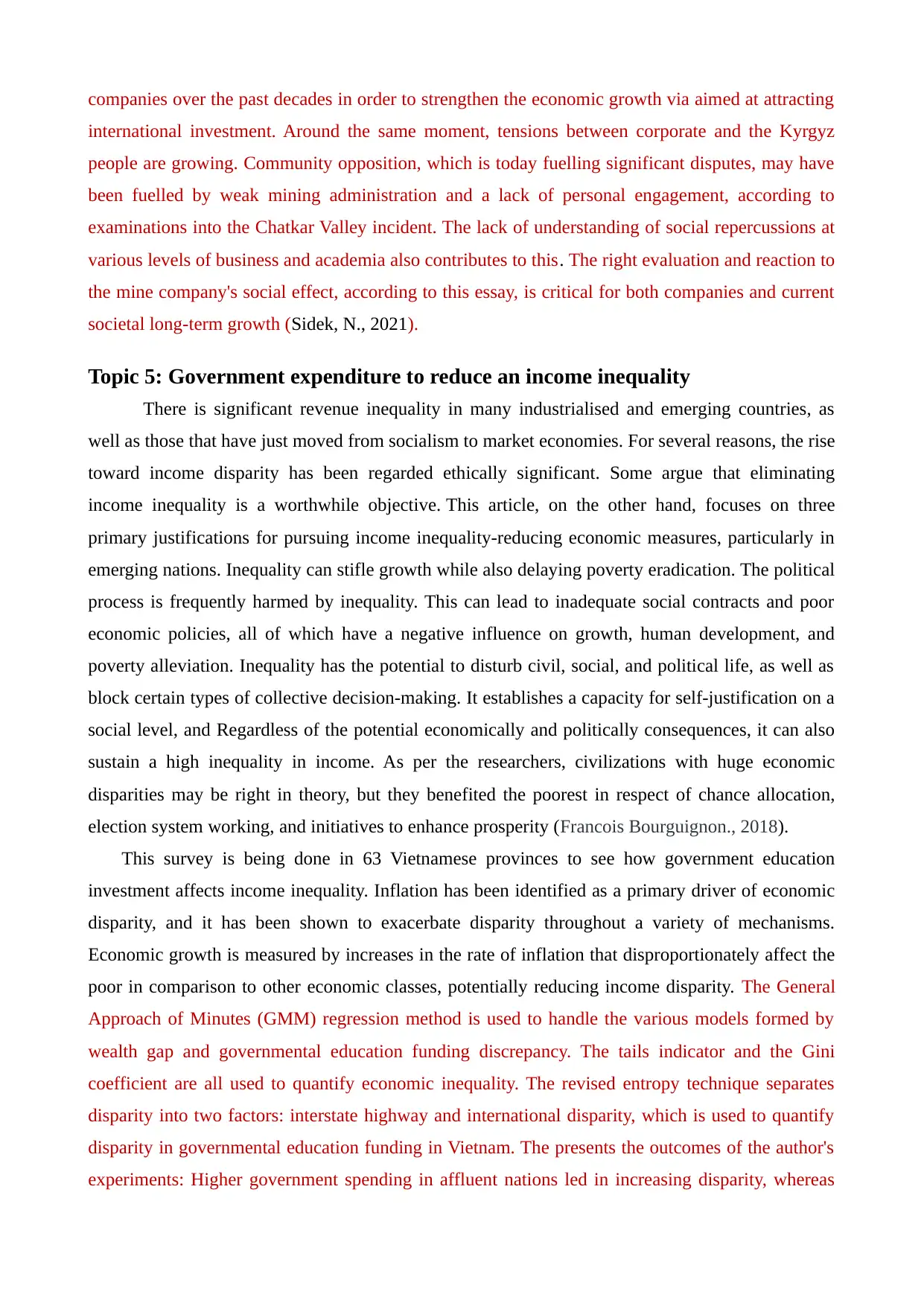
companies over the past decades in order to strengthen the economic growth via aimed at attracting
international investment. Around the same moment, tensions between corporate and the Kyrgyz
people are growing. Community opposition, which is today fuelling significant disputes, may have
been fuelled by weak mining administration and a lack of personal engagement, according to
examinations into the Chatkar Valley incident. The lack of understanding of social repercussions at
various levels of business and academia also contributes to this. The right evaluation and reaction to
the mine company's social effect, according to this essay, is critical for both companies and current
societal long-term growth (Sidek, N., 2021).
Topic 5: Government expenditure to reduce an income inequality
There is significant revenue inequality in many industrialised and emerging countries, as
well as those that have just moved from socialism to market economies. For several reasons, the rise
toward income disparity has been regarded ethically significant. Some argue that eliminating
income inequality is a worthwhile objective. This article, on the other hand, focuses on three
primary justifications for pursuing income inequality-reducing economic measures, particularly in
emerging nations. Inequality can stifle growth while also delaying poverty eradication. The political
process is frequently harmed by inequality. This can lead to inadequate social contracts and poor
economic policies, all of which have a negative influence on growth, human development, and
poverty alleviation. Inequality has the potential to disturb civil, social, and political life, as well as
block certain types of collective decision-making. It establishes a capacity for self-justification on a
social level, and Regardless of the potential economically and politically consequences, it can also
sustain a high inequality in income. As per the researchers, civilizations with huge economic
disparities may be right in theory, but they benefited the poorest in respect of chance allocation,
election system working, and initiatives to enhance prosperity (Francois Bourguignon., 2018).
This survey is being done in 63 Vietnamese provinces to see how government education
investment affects income inequality. Inflation has been identified as a primary driver of economic
disparity, and it has been shown to exacerbate disparity throughout a variety of mechanisms.
Economic growth is measured by increases in the rate of inflation that disproportionately affect the
poor in comparison to other economic classes, potentially reducing income disparity. The General
Approach of Minutes (GMM) regression method is used to handle the various models formed by
wealth gap and governmental education funding discrepancy. The tails indicator and the Gini
coefficient are all used to quantify economic inequality. The revised entropy technique separates
disparity into two factors: interstate highway and international disparity, which is used to quantify
disparity in governmental education funding in Vietnam. The presents the outcomes of the author's
experiments: Higher government spending in affluent nations led in increasing disparity, whereas
international investment. Around the same moment, tensions between corporate and the Kyrgyz
people are growing. Community opposition, which is today fuelling significant disputes, may have
been fuelled by weak mining administration and a lack of personal engagement, according to
examinations into the Chatkar Valley incident. The lack of understanding of social repercussions at
various levels of business and academia also contributes to this. The right evaluation and reaction to
the mine company's social effect, according to this essay, is critical for both companies and current
societal long-term growth (Sidek, N., 2021).
Topic 5: Government expenditure to reduce an income inequality
There is significant revenue inequality in many industrialised and emerging countries, as
well as those that have just moved from socialism to market economies. For several reasons, the rise
toward income disparity has been regarded ethically significant. Some argue that eliminating
income inequality is a worthwhile objective. This article, on the other hand, focuses on three
primary justifications for pursuing income inequality-reducing economic measures, particularly in
emerging nations. Inequality can stifle growth while also delaying poverty eradication. The political
process is frequently harmed by inequality. This can lead to inadequate social contracts and poor
economic policies, all of which have a negative influence on growth, human development, and
poverty alleviation. Inequality has the potential to disturb civil, social, and political life, as well as
block certain types of collective decision-making. It establishes a capacity for self-justification on a
social level, and Regardless of the potential economically and politically consequences, it can also
sustain a high inequality in income. As per the researchers, civilizations with huge economic
disparities may be right in theory, but they benefited the poorest in respect of chance allocation,
election system working, and initiatives to enhance prosperity (Francois Bourguignon., 2018).
This survey is being done in 63 Vietnamese provinces to see how government education
investment affects income inequality. Inflation has been identified as a primary driver of economic
disparity, and it has been shown to exacerbate disparity throughout a variety of mechanisms.
Economic growth is measured by increases in the rate of inflation that disproportionately affect the
poor in comparison to other economic classes, potentially reducing income disparity. The General
Approach of Minutes (GMM) regression method is used to handle the various models formed by
wealth gap and governmental education funding discrepancy. The tails indicator and the Gini
coefficient are all used to quantify economic inequality. The revised entropy technique separates
disparity into two factors: interstate highway and international disparity, which is used to quantify
disparity in governmental education funding in Vietnam. The presents the outcomes of the author's
experiments: Higher government spending in affluent nations led in increasing disparity, whereas
⊘ This is a preview!⊘
Do you want full access?
Subscribe today to unlock all pages.

Trusted by 1+ million students worldwide

learning and development spending in poorer nations were seen as motivating factors towards
decreasing economic inequality. It has aided me in identifying areas wherein action is needed for
the nation's economic development by assisting me in identifying strategies to lessen income
disparity.
CONCLUSION
According to the aforementioned research, the governments across the globe have made
steps to eliminate poverty in their different nations. They use a variety of approaches and
instruments to try to lessen income disparity. Additionally, numerous writers' research is presented
in this article in attempt to induce the politicians to create the most suitable and necessary
expenditures in order to reduce inequality. The researcher’s offers a number of initiatives that an
administration might do to assist reduce income disparity in their nation. In this report present the
different problems which are facing by government in regard poverty and inequality that impact on
growth of economy. Along with identify that how to different topics are presented different
countries problems in effective manner.
decreasing economic inequality. It has aided me in identifying areas wherein action is needed for
the nation's economic development by assisting me in identifying strategies to lessen income
disparity.
CONCLUSION
According to the aforementioned research, the governments across the globe have made
steps to eliminate poverty in their different nations. They use a variety of approaches and
instruments to try to lessen income disparity. Additionally, numerous writers' research is presented
in this article in attempt to induce the politicians to create the most suitable and necessary
expenditures in order to reduce inequality. The researcher’s offers a number of initiatives that an
administration might do to assist reduce income disparity in their nation. In this report present the
different problems which are facing by government in regard poverty and inequality that impact on
growth of economy. Along with identify that how to different topics are presented different
countries problems in effective manner.
Paraphrase This Document
Need a fresh take? Get an instant paraphrase of this document with our AI Paraphraser
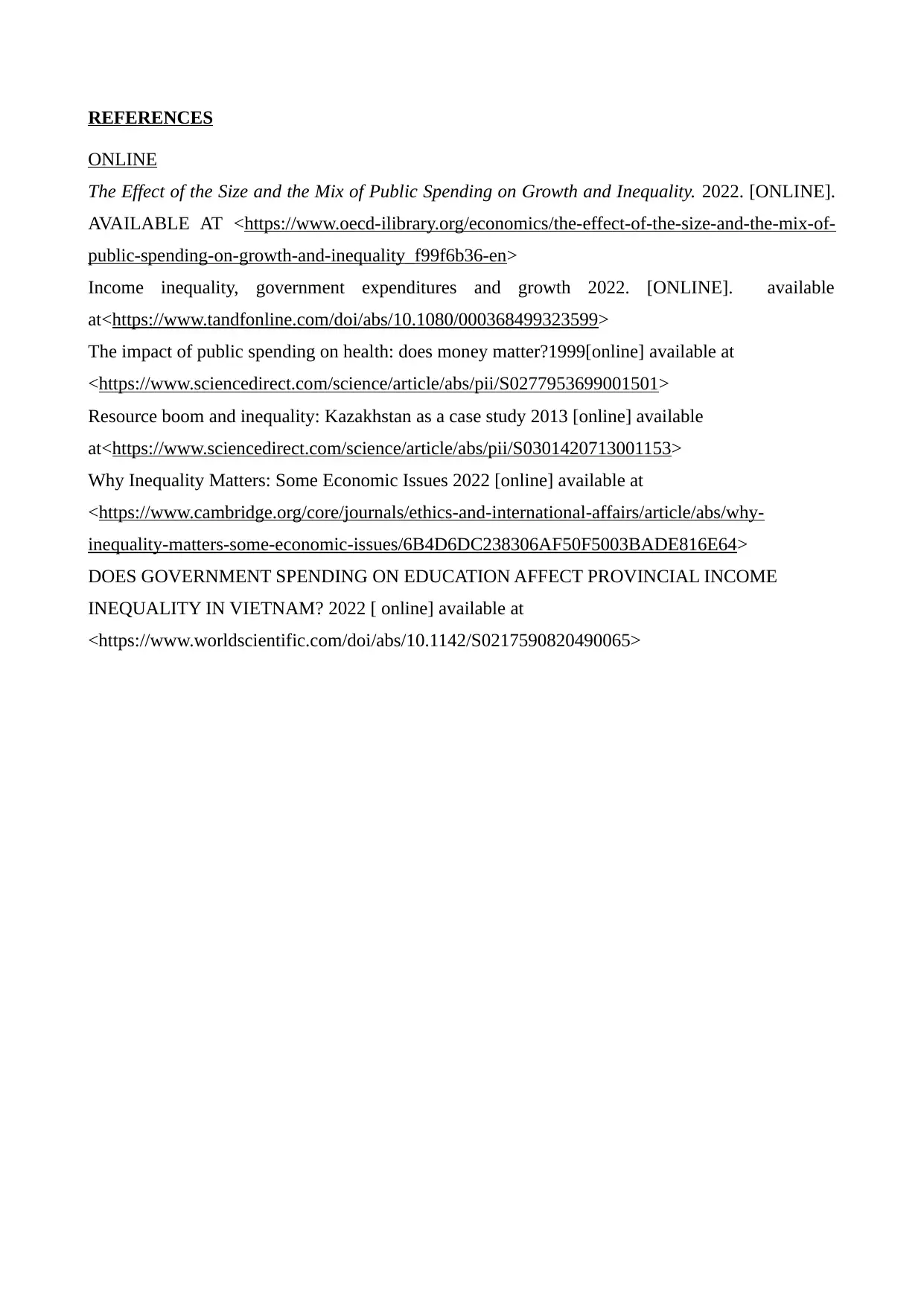
REFERENCES
ONLINE
The Effect of the Size and the Mix of Public Spending on Growth and Inequality. 2022. [ONLINE].
AVAILABLE AT <https://www.oecd-ilibrary.org/economics/the-effect-of-the-size-and-the-mix-of-
public-spending-on-growth-and-inequality_f99f6b36-en>
Income inequality, government expenditures and growth 2022. [ONLINE]. available
at<https://www.tandfonline.com/doi/abs/10.1080/000368499323599>
The impact of public spending on health: does money matter?1999[online] available at
<https://www.sciencedirect.com/science/article/abs/pii/S0277953699001501>
Resource boom and inequality: Kazakhstan as a case study 2013 [online] available
at<https://www.sciencedirect.com/science/article/abs/pii/S0301420713001153>
Why Inequality Matters: Some Economic Issues 2022 [online] available at
<https://www.cambridge.org/core/journals/ethics-and-international-affairs/article/abs/why-
inequality-matters-some-economic-issues/6B4D6DC238306AF50F5003BADE816E64>
DOES GOVERNMENT SPENDING ON EDUCATION AFFECT PROVINCIAL INCOME
INEQUALITY IN VIETNAM? 2022 [ online] available at
<https://www.worldscientific.com/doi/abs/10.1142/S0217590820490065>
ONLINE
The Effect of the Size and the Mix of Public Spending on Growth and Inequality. 2022. [ONLINE].
AVAILABLE AT <https://www.oecd-ilibrary.org/economics/the-effect-of-the-size-and-the-mix-of-
public-spending-on-growth-and-inequality_f99f6b36-en>
Income inequality, government expenditures and growth 2022. [ONLINE]. available
at<https://www.tandfonline.com/doi/abs/10.1080/000368499323599>
The impact of public spending on health: does money matter?1999[online] available at
<https://www.sciencedirect.com/science/article/abs/pii/S0277953699001501>
Resource boom and inequality: Kazakhstan as a case study 2013 [online] available
at<https://www.sciencedirect.com/science/article/abs/pii/S0301420713001153>
Why Inequality Matters: Some Economic Issues 2022 [online] available at
<https://www.cambridge.org/core/journals/ethics-and-international-affairs/article/abs/why-
inequality-matters-some-economic-issues/6B4D6DC238306AF50F5003BADE816E64>
DOES GOVERNMENT SPENDING ON EDUCATION AFFECT PROVINCIAL INCOME
INEQUALITY IN VIETNAM? 2022 [ online] available at
<https://www.worldscientific.com/doi/abs/10.1142/S0217590820490065>
1 out of 8
Related Documents
Your All-in-One AI-Powered Toolkit for Academic Success.
+13062052269
info@desklib.com
Available 24*7 on WhatsApp / Email
![[object Object]](/_next/static/media/star-bottom.7253800d.svg)
Unlock your academic potential
Copyright © 2020–2025 A2Z Services. All Rights Reserved. Developed and managed by ZUCOL.




